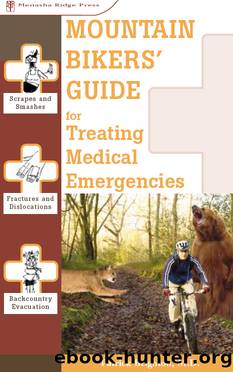Mountain Bikers' Guide to Treating Medical Emergencies by Patrick Brighton

Author:Patrick Brighton
Language: eng
Format: epub
ISBN: eBook ISBN: 9780897327909
Publisher: Menasha Ridge Press
Published: 2005-03-15T00:00:00+00:00
TREATMENT
So, what the heck do you do for your buddy when he breaks his leg? First, take a couple of deep breaths and try not to toss your trail mix, because the sight of a limb bending at unnatural angles or the sound of snapped bones grating on each other can be really nauseating. As always, think âA-B-Câ, then get the victim (or yourself, if alone) to a safe, warm, dry place, and arrange the injured area so that the pain is the least. Immediately after a bone is broken, the body initiates a defense response that results in massive swelling around the area. This represents eons of evolutionâan attempt at an auto-splint if you will. If not otherwise apparent, this may be the main clue that a fracture exists. Next, you will need to look at both the injured area as well as the limb (assuming an extremity fracture) down toward the fingers or toes. This is because sometimes a broken bone may become displacedâno, not misplaced.
Displaced means that the broken bone fragments are no longer in a normal, straight alignment. This may cause the broken fragment to kink, block, or even cut blood vessels inside the limb.
Why is this important, you ask? Iâm glad you asked. Itâs important because a broken bone does not normally represent a life- or even limb-threatening emergency. You may even have days to get the injured person to definitive medical help without any negative consequences. If, however, the blood vessels (arteries, here) are blocked, the person may lose the extremity after only a single hour of ischemia (no blood flow). For instance, if your partner breaks her leg and you are not able to locate a foot pulse, you have to start thinking about impaired blood flow. To compare, feel for the pulse on the other foot (or hand, if it is the arm that is broken). If you canât feel the pulse here either, then itâs probably one of three things: (1) you are feeling in the wrong areaârecheck the diagrams and/or ask someone else to cop a feel; (2) the person is in shock, in which case the peripheral arteries (i.e., those at the wrist and ankle) will be clamped and hard to feel; or (3) the person is cold, in which case, again, the arteries will be clamped.
Download
This site does not store any files on its server. We only index and link to content provided by other sites. Please contact the content providers to delete copyright contents if any and email us, we'll remove relevant links or contents immediately.
Shoe Dog by Phil Knight(5085)
The Rules Do Not Apply by Ariel Levy(4795)
Walking by Henry David Thoreau(3863)
How to Read Water: Clues and Patterns from Puddles to the Sea (Natural Navigation) by Tristan Gooley(3376)
Running Barefoot by Amy Harmon(3373)
I'll Give You the Sun by Jandy Nelson(3334)
Crazy Is My Superpower by A.J. Mendez Brooks(3277)
How to Read Nature by Tristan Gooley(3217)
How Music Works by David Byrne(3089)
The Boy, the Mole, the Fox and the Horse by Charlie Mackesy(2931)
The Fight by Norman Mailer(2808)
Seducing Cinderella by Gina L. Maxwell(2582)
Cuba by Lonely Planet(2533)
Accepted by Pat Patterson(2272)
Going Long by Editors of Runner's World(2257)
The Unfettered Mind: Writings from a Zen Master to a Master Swordsman by Takuan Soho(2208)
The Happy Runner by David Roche(2171)
Backpacker the Complete Guide to Backpacking by Backpacker Magazine(2155)
Trail Magic by Trevelyan Quest Edwards & Hazel Edwards(2109)
